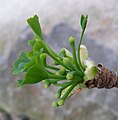Ginkgo biloba
| Ginkgo biloba | |
|---|---|
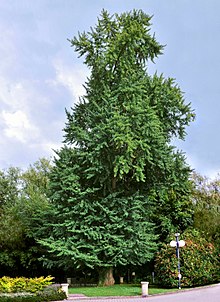
| |
| Scientific classification | |
| Kingdom: | Plantae |
| Clade: | Tracheophytes |
| Clade: | Gymnospermae |
| Division: | Ginkgophyta |
| Class: | Ginkgoopsida |
| Order: | Ginkgoales |
| Family: | Ginkgoaceae |
| Genus: | Ginkgo |
| Species: | G. biloba
|
| Binomial name | |
| Ginkgo biloba | |
| Synonyms[4] | |
| |
Ginkgo biloba, commonly known as ginkgo or gingko (/ˈɡɪŋkoʊ, ˈɡɪŋkɡoʊ/ GINK-oh, -goh),[5][6] also known as the maidenhair tree,[7] is a species of gymnosperm tree native to East Asia. It is the last living species in the order Ginkgoales, which first appeared over 290 million years ago, and fossils very similar to the living species, belonging to the genus Ginkgo, extend back to the Middle Jurassic epoch approximately 170 million years ago.[2] The tree was cultivated early in human history and remains commonly planted, and is widely regarded as a living fossil.
The plant may be toxic or allergenic in certain cases. Leaf extract is commonly used as a dietary supplement, but there is insufficient clinical evidence that it supports human health or is effective against any disease.[8][9]
Description
[edit]
Ginkgos are large trees, normally reaching a height of 20–35 m (66–115 ft),[10] with some specimens in China being over 50 m (165 ft). The tree has an angular crown and long, somewhat erratic branches, and is usually deep-rooted and resistant to wind and snow damage. Young trees are often tall and slender, and sparsely branched; the crown becomes broader as the tree ages. A combination of resistance to disease, insect-resistant wood, and the ability to form aerial roots and sprouts makes ginkgos durable, with some specimens claimed to be more than 2,500 years old.[11]
Leaves
[edit]

The leaves are unique among seed plants, being fan-shaped with veins radiating out into the leaf blade, sometimes bifurcating (splitting), but never anastomosing to form a network.[12] Two veins enter the leaf blade at the base and fork repeatedly in two; this is known as dichotomous venation. The leaves are usually 5–10 cm (2–4 in), but sometimes up to 15 cm (6 in) long. The old common name, maidenhair tree, derives from the leaves resembling pinnae of the maidenhair fern, Adiantum capillus-veneris. Ginkgos are prized for their autumn foliage, which is a deep saffron yellow.[13]
Leaves of long shoots are usually notched or lobed, but only from the outer surface, between the veins. They are borne both on the more rapidly growing branch tips, where they are alternate and spaced out, and also on the short, stubby spur shoots, where they are clustered at the tips. Leaves are green both on the top and bottom[14] and have stomata on both sides.[15] During autumn, the leaves turn a bright yellow and then fall, sometimes within a short space of time (one to fifteen days).[16]
Branches
[edit]Ginkgo branches grow in length by growth of shoots with regularly spaced leaves, as seen on most trees. From the axils of these leaves, "spur shoots" (also known as short shoots) develop on second-year growth. Short shoots have short internodes (they may grow only one to two centimeters in several years) and their leaves are usually unlobed. They are short and knobby, and are arranged regularly on the branches except on first-year growth. Because of the short internodes, leaves appear to be clustered at the tips of short shoots, and reproductive structures are formed only on them (see pictures below – seeds and leaves are visible on short shoots). In ginkgos, as in other plants that possess them, short shoots allow the formation of new leaves in the older parts of the crown. After a number of years, a short shoot may change into a long (ordinary) shoot, or vice versa.[17]
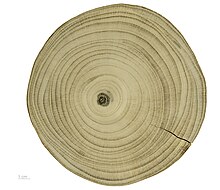
Ginkgo prefers full sun and grows best in environments that are well-watered and well-drained. The species shows a preference for disturbed sites; in the "semiwild" stands at Tianmu Mountains, many specimens are found along stream banks, rocky slopes, and cliff edges. Accordingly, ginkgo retains a prodigious capacity for vegetative growth. It is capable of sprouting from embedded buds near the base of the trunk (lignotubers, or basal chichi) in response to disturbances, such as soil erosion. Old specimens are also capable of producing aerial roots on the undersides of large branches in response to disturbances such as crown damage; these roots can lead to successful clonal reproduction upon contacting the soil. These strategies are evidently important in the persistence of ginkgo; in a survey of the "semiwild" stands remaining in Tianmushan, 40% of the specimens surveyed were multi-stemmed, and few saplings were present.[18]: 86–87
Reproduction
[edit]Ginkgo biloba is dioecious, with separate sexes, some trees being female and others being male.[19] Male plants produce small pollen cones with sporophylls, each bearing two microsporangia spirally arranged around a central axis. Sex conversion, wherein certain branches of a tree change sexes, has been observed.[20] This phenomenon is difficult to research because of its rarity as well as the practice of grafting female branches onto otherwise male trees that was common in 19th century Europe.[21]
Female plants do not produce cones. Two ovules are formed at the end of a stalk, and after wind pollination,[22] one or both develop into fruit-like structures containing seeds. The fruits are 1.5–2 cm long, with a soft, fleshy, yellow-brown outer layer (the sarcotesta) that is attractive in appearance, but contains butyric acid[23] (also known as butanoic acid) and smells foul like rancid butter or vomit[24] when fallen. Beneath the sarcotesta is the hard sclerotesta (the "shell" of the seed) and a papery endotesta, with the nucellus surrounding the female gametophyte at the center.[25]
The fertilization of ginkgo seeds occurs via motile sperm, as in cycads, ferns, mosses, and algae. The sperm are large (about 70–90 micrometres)[26] and are similar to the sperm of cycads, which are slightly larger. Ginkgo sperm were first discovered by the Japanese botanist Sakugoro Hirase in 1896.[27] The sperm have a complex multi-layered structure, which is a continuous belt of basal bodies that form the base of several thousand flagella which have a cilia-like motion. The flagella/cilia apparatus pulls the body of the sperm forwards. The sperm have only a tiny distance to travel to the archegonia, of which there are usually two or three. Two sperm are produced, one of which successfully fertilizes the ovule. Fertilization of ginkgo seeds occurs just before or after they fall in early autumn.[12][25] Embryos may develop in the seeds before or after they drop from the tree.[28]
Genome
[edit]Chinese scientists published a draft genome of Ginkgo biloba in 2016.[29] The tree has a large genome of 10.6 billion DNA nucleobase "letters" (the human genome has three billion) and about 41,840 predicted genes[30] which enable a considerable number of antibacterial and chemical defense mechanisms.[29] 76.58% of the assembled sequence turned out to be repetitive sequences.[31]
In 2020, a study in China of ginkgo trees up to 667 years old showed little effects of aging, finding that the trees continued to grow with age and displayed no genetic evidence of senescence, and continued to make phytochemicals indefinitely.[32]
Phytochemicals
[edit]Extracts of ginkgo leaves contain phenolic acids, proanthocyanidins, flavonoid glycosides, such as myricetin, kaempferol, isorhamnetin, and quercetin, and the terpene trilactones ginkgolides and bilobalides.[9][33][34] The leaves also contain unique ginkgo biflavones, alkylphenols, and polyprenols.[34]
Taxonomy
[edit]The older Chinese name for this plant is 銀果, meaning "silver fruit", pronounced yínguǒ in Mandarin or Ngan-gwo in Cantonese. The current commonly used names are 白果 (bái guǒ), meaning "white fruit", and 銀杏 (yínxìng), meaning "silver apricot". The name 銀杏 was translated into Japanese as イチョウ (ichou) or ぎんなん (ginnan) and into Korean as 은행 (eunhaeng).
Carl Linnaeus described the species in 1771, the specific epithet biloba derived from the Latin bis, "twice" and loba, "lobed", referring to the shape of the leaves.[35] Two names for the species recognise the botanist Richard Salisbury, a placement by Nelson as Pterophyllus salisburiensis and the earlier Salisburia adiantifolia proposed by James Edward Smith. The epithet of the latter may have been intended to denote a characteristic resembling Adiantum, the genus of maidenhair ferns.[36]
The scientific name Ginkgo is the result of a spelling error that occurred three centuries ago. Kanji typically have multiple pronunciations in Japanese, and the characters 銀杏 used for ginnan can also be pronounced ginkyō. Engelbert Kaempfer, the first Westerner to investigate the species in 1690, wrote down this pronunciation in the notes that he later used for the Amoenitates Exoticae (1712) with the "awkward" spelling "ginkgo".[37] This appears to be a simple error of Kaempfer; taking his spelling of other Japanese words containing the syllable "kyō" into account, a more precise romanization following his writing habits would have been "ginkio" or "ginkjo".[38] Linnaeus, who relied on Kaempfer when dealing with Japanese plants, adopted the spelling given in Kaempfer's "Flora Japonica" (Amoenitates Exoticae, p. 811). Kaempfer's drawing can be found in Hori's article.[39]
Classification
[edit]The relationship of ginkgo to other plant groups remains uncertain. It has been placed loosely in the divisions Spermatophyta and Pinophyta, but no consensus has been reached. Since its seeds are not protected by an ovary wall, it can morphologically be considered a gymnosperm. The apricot-like structures produced by female ginkgo trees are technically not fruits, but are seeds that have a shell consisting of a soft and fleshy section (the sarcotesta), and a hard section (the sclerotesta). The sarcotesta has a strong smell that most people find unpleasant.[40][41][42]
The ginkgo is classified in its own division, the Ginkgophyta, comprising the single class Ginkgoopsida, order Ginkgoales, family Ginkgoaceae, genus Ginkgo and is the only extant species within this group. It is one of the best-known examples of a living fossil, because Ginkgoales other than G. biloba are not known from the fossil record after the Pliocene.[43][44]
-
Extinct Ginkgo yimaensis[45]
-
Extant G. biloba[45]
Phylogeny
[edit]
Ginkgo biloba is a living fossil, with fossils recognisably related to modern ginkgo from the early Permian (Cisuralian), with likely oldest record being that of Trichopitys from the earliest Permian (Asselian) of France, over 290 million years old.[46] The closest living relatives of the clade are the cycads,[18]: 84 which share with the extant G. biloba the characteristic of motile sperm.
Such plants with leaves that have more than four veins per segment have customarily been assigned to the taxon Ginkgo, while the taxon Baiera is used to classify those with fewer than four veins per segment. Sphenobaiera has been used for plants with a broadly wedge-shaped leaf that lacks a distinct leaf stem.[47][48]
Rise and decline
[edit]
Fossils attributable to the genus Ginkgo first appeared in the Middle Jurassic. The genus Ginkgo diversified and spread throughout Laurasia during the Jurassic and Early Cretaceous.[46]
The Ginkgophyta declined in diversity as the Cretaceous progressed, and by the Paleocene, Ginkgo adiantoides was the only Ginkgo species left in the Northern Hemisphere, while a markedly different (and poorly documented) form persisted in the Southern Hemisphere. Along with that of ferns, cycads, and cycadeoids, the species diversity in the genus Ginkgo drops through the Cretaceous, at the same time the flowering plants were on the rise; this supports the hypothesis that, over time, flowering plants with better adaptations to disturbance displaced Ginkgo and its associates.[18]: 93
At the end of the Pliocene, Ginkgo fossils disappeared from the fossil record everywhere except in a small area of central China, where the modern species survived.
Limited number of species
[edit]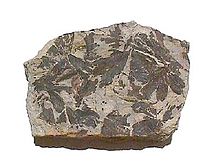
It is doubtful whether the Northern Hemisphere fossil species of Ginkgo can be reliably distinguished. Given the slow pace of evolution and morphological similarity between members of the genus, there may have been only one or two species existing in the Northern Hemisphere through the entirety of the Cenozoic: present-day G. biloba (including G. adiantoides) and G. gardneri from the Paleocene of Scotland.[18]: 85
At least morphologically, G. gardneri and the Southern Hemisphere species are the only known post-Jurassic taxa that can be unequivocally recognised. The remainder may have been ecotypes or subspecies. The implications would be that G. biloba had occurred over an extremely wide range, had remarkable genetic flexibility and, though evolving genetically, never showed much speciation.[49][50]
While it may seem improbable that a single species may exist as a contiguous entity for many millions of years, many of the ginkgo's life-history parameters fit: Extreme longevity; slow reproduction rate; (in Cenozoic and later times) a wide, apparently contiguous, but steadily contracting distribution; and (as far as can be demonstrated from the fossil record) extreme ecological conservatism (restriction to disturbed streamside environments).[18]: 91
Adaptation to a single environment
[edit]Given the slow rate of evolution of the genus, Ginkgo possibly represents a pre-angiosperm strategy for survival in disturbed streamside environments. Ginkgo evolved in an era before flowering plants, when ferns, cycads, and cycadeoids dominated disturbed streamside environments, forming low, open, shrubby canopies. Ginkgo's large seeds and habit of "bolting" – growing to a height of 10 meters before elongating its side branches – may be adaptations to such an environment.
Modern-day G. biloba grows best in environments that are well-watered and drained,[18]: 87 and the extremely similar fossil Ginkgo favored similar environments: The sediment record at the majority of fossil Ginkgo localities indicates it grew primarily in disturbed environments, such as along streams.[18] Ginkgo, therefore, presents an "ecological paradox" because while it possesses some favorable traits for living in disturbed environments (clonal reproduction) many of its other life-history traits are the opposite of those exhibited by modern plants that thrive in disturbed settings (slow growth, large seed size, late reproductive maturity).[18]: 92
Etymology
[edit]The genus name is regarded as a misspelling of the Japanese pronunciation gin kyō ([ɡiŋkʲoː]) for the kanji 銀杏 meaning "silver apricot",[51] which is found in Chinese herbology literature such as 日用本草 (Daily Use Materia Medica) (1329) and Compendium of Materia Medica 本草綱目 published in 1578.[39]
Despite its spelling, which is due to a complicated etymology including a transcription error, "ginkgo" is usually pronounced /ˈɡɪŋkoʊ/, which has given rise to the common alternative spelling "gingko". The spelling pronunciation /ˈɡɪŋkɡoʊ/ is also documented in some dictionaries.[52][53]
Engelbert Kaempfer first introduced the spelling ginkgo in his book Amoenitatum Exoticarum of 1712.[54] It is considered that he may have misspelled "Ginkjo" or "Ginkio" (both consistent with his treatment of Japanese kyō in the same work) as "Ginkgo". This misspelling was included by Linnaeus in his book Mantissa plantarum II[55] and has become the name of the tree's genus.[38][52] The specific epithet biloba is New Latin for "two-lobed".
Distribution and habitat
[edit]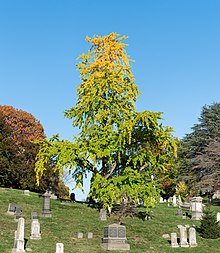
Although Ginkgo biloba and other species of the genus were once widespread throughout the world, its habitat had shrunk by two million years ago.
For centuries, it was thought to be extinct in the wild,[56] but is now a common tree cultivated throughout eastern China, Korea, and Japan. Many municipalities in Korea and Japan use Ginkgos as street trees, and Ginkgo leaves are the emblem of prominent educational institutions such as the University of Tokyo and Sungkyunkwan University in South Korea. Despite their widespread habitat, high genetic uniformity exists among ginkgo trees, with some Chinese scholars suggesting that ginkgo trees in these areas may have been planted and preserved by Chinese monks over about 1,000 years.[57] A study demonstrates a greater genetic diversity in Southwestern China populations, supporting glacial refugia in mountains surrounding the eastern Tibetan Plateau, where several old-growth candidates for wild populations have been reported.[57][58] Recently, the findings of Ginkgo trees aged 1,500 years in Samcheok-si, Korea (the Neukguri Ginkgo, designated as Korea's natural artifact in 1986),[59] and aged 1,200 in Tsurugaoka Hachimangu Shrine in Japan have discredited theories claiming Chinese origins of Ginkgo.[citation needed] Whether native ginkgo populations still exist has not been demonstrated unequivocally, but there is genetic evidence that these Southwestern populations may be wild, as well as evidence that the largest and oldest G. biloba trees may be older than surrounding human settlements.[57]
Where it occurs in the wild, Ginkgo is found infrequently in deciduous forests and valleys on acidic loess (i.e. fine, silty soil) with good drainage. The soil it inhabits is typically in the pH range of 5.0 to 5.5.[60]
Cultivation
[edit]
Ginkgo has long been cultivated in China. It is common in the southern third of the country.[60] Some planted trees at temples are believed to be over 1,500 years old. The first record of Europeans encountering it is in 1690 in Japanese temple gardens, where the tree was seen by the German botanist Engelbert Kaempfer. Because of its status in Buddhism and Confucianism, the ginkgo has also been widely planted in Korea and in Japan since the 14th century;[61] in both areas, some naturalization has occurred, with ginkgos seeding into natural forests. Ginkgo has been commonly cultivated in North America for over 200 years and in Europe for close to 300, but during that time, it has never become significantly naturalized.[62]
G. biloba is also commonly manually planted in cities across the United States and Europe. This species is highly tolerant to pollution and serves as a visually appealing, shade-providing tree in many cities and gardens.[63]
Many intentionally planted ginkgos are male cultivars grafted onto plants propagated from seed, because the male trees will not produce the malodorous seeds. The popular cultivar 'Autumn Gold' is a clone of a male plant.[citation needed]
The disadvantage of male Ginkgo biloba trees is that they are highly allergenic. They have an OPALS (Ogren Plant Allergy Scale) rating of 7 (out of 10), whereas female trees, which can produce no pollen, have an OPALS allergy scale rating of 2.[64]
Female cultivars include 'Liberty Splendor', 'Santa Cruz', and 'Golden Girl', the latter so named because of the striking yellow color of its leaves in the fall; all female cultivars release zero pollen.[64]
Many cultivars are listed in the literature in the UK, of which the compact 'Troll' has gained the Royal Horticultural Society's Award of Garden Merit.[65][66]
Ginkgos adapt well to the urban environment, tolerating pollution and confined soil spaces.[67] They rarely have disease problems, even in urban conditions, and are attacked by few insects.[68][69]
Ginkgos are popular subjects for growing as miniature landscapes known as penjing and bonsai;[70] they can be kept artificially small and tended over centuries. The trees are easy to propagate from seed.
Hiroshima
[edit]Extreme examples of the ginkgo's tenacity may be seen in Hiroshima, Japan, where six trees growing between 1 and 2 kilometres (1⁄2 and 1+1⁄4 miles) from the 1945 atom bomb explosion were among the few living organisms in the area to survive the blast. Although almost all other plants (and animals) in the area were killed, the ginkgos, though charred, survived and were soon healthy again, among other hibakujumoku (trees that survived the blast).[71]
The six trees are still alive: They are marked with signs at Housenbou (報専坊) temple (planted in 1850), Shukkei-en (planted about 1740), Jōsei-ji (planted 1900), at the former site of Senda Elementary School near Miyukibashi, at the Myōjōin temple, and an Edo period-cutting at Anraku-ji temple.[72]
1000-year-old ginkgo at Tsurugaoka Hachimangū
[edit]
At the Tsurugaoka Hachiman-gū's shrine in the city of Kamakura, Kanagawa Prefecture, Japan, an ancient ginkgo tree stands beside the stone entry staircase. According to legend, the tree has stood there since the founding of the shrine circa 1063.[73] The tree is nicknamed kakure-ichō (hiding ginkgo), because of an Edo period legend in which shōgun Minamoto no Sanetomo was assassinated in 1219 by his nephew, Kugyō, who had hidden behind the tree to ambush the shōgun.[73]
Modern scholarship has established that ginkgos arrived from China in the 14th century, and a 1990 tree-ring measurement indicated the kakure-ichō's age to be about 500 years.[39]
On 10 March 2010, the tree blew down in a storm, but the stump has since sprouted vigorously.[73]
1,400-year-old ginkgo tree at Gu Guanyin
[edit]The grounds of the Buddhist temple at Gu Guanyin in the Zhongnan Mountains feature a ginkgo tree reputed to be 1,400 years old.[74][75] The tree itself is a popular tourist attraction.
Toxicity
[edit]Since 2016, G. biloba extract is classified as a possible human carcinogen (group 2B) by the International Agency for Research on Cancer.[76]
When eaten in large quantities or over a long period, the seeds may cause poisoning by ginkgotoxin (4'-O-methylpyridoxine, MPN), as found in a few case reports.[77][78] A heat-stable compound not destroyed by cooking, MPN may cause convulsions, which were alleviated by treatment with pyridoxine phosphate (vitamin B6), according to limited studies.[77][78]
Some people are sensitive to the chemicals in the sarcotesta, the outer fleshy coating. These people should handle the seeds with care when preparing the seeds for consumption, wearing disposable gloves. The symptoms are allergic contact dermatitis,[79][80] or blisters similar to that caused by contact with poison ivy.[81]
Side effects of using ginkgo supplements may include increased risk of bleeding, gastrointestinal discomfort, nausea, vomiting, diarrhea, headaches, dizziness, heart palpitations, and restlessness.[8][9] Although use of standardized Ginkgo biloba leaf extracts in moderate amounts appears to be safe,[8] excessive use may have undesirable effects, especially in terms of drug interactions.[9] The dosing of anticoagulants, such as warfarin or antiplatelet medication, may be adversely affected by using ginkgo supplements.[8][9]
According to a systemic review, the effects of ginkgo on pregnant women may include increased bleeding time, and there is inadequate information about safety during lactation.[9][82]
Ginkgo pollen may produce allergic reactions.[9] Ginkgo biloba leaves and sarcotesta contain ginkgolic acids[83] – which are highly allergenic – long-chain alkylphenols, such as bilobol or adipostatin A[84] (bilobol is a substance related to anacardic acid from cashew nut shells and urushiols present in poison ivy and other Toxicodendron spp.)[9][80] Individuals with a history of strong allergic reactions to poison ivy, mangoes, cashews and other alkylphenol-producing plants are more likely to experience an allergic reaction when consuming non-standardized ginkgo-containing preparations.[9] The level of these allergens in standardized pharmaceutical preparations from Ginkgo biloba was restricted to 5 ppm by the Commission E of the former Federal German Health Authority. Overconsumption of seeds from Ginkgo biloba can deplete vitamin B6.[85][86]
Uses
[edit]The wood of Ginkgo biloba is used to make furniture, chessboards, carving, and casks for making saké; the wood is fire-resistant and slow to decay.[56]
Culinary
[edit]


Despite the health risks in certain cases, the nut-like kernels of the seeds are esteemed in Asia, and are a traditional ingredient in Chinese food. Ginkgo nuts are used in congee, and are often served at special occasions such as weddings and the Chinese New Year (as part of the vegetarian dish called Buddha's delight). Japanese cooks add ginkgo seeds (called ginnan) to dishes such as chawanmushi, and cooked seeds are often eaten along with other dishes. Grilled ginkgo nuts with salt are also a popular item at izakayas as a healthy snack with beer and other Japanese food.[87] In Korea, ginkgo nuts are stir-fried and eaten, or are used to garnish foods such as sinseonro.[88]
Medical research
[edit]Although extracts of Ginkgo biloba leaf are often marketed as cognitive enhancers, there is no evidence for effects on memory or attention in healthy people.[8][89] Systematic reviews have shown there is no evidence for effectiveness of ginkgo in treating high blood pressure,[90] menopause-related cognitive decline,[91] tinnitus,[92][93] post-stroke recovery,[94] or altitude sickness.[95]
There is weak preliminary evidence for ginkgo affecting dementia[96][97][98] and tardive dyskinesia symptoms in people with schizophrenia.[99]
Traditional medicine
[edit]Ginkgo has been used in traditional Chinese medicine since at least the 11th century CE.[100] Ginkgo seeds, leaves, and nuts have traditionally been used to treat various ailments, such as dementia, asthma, bronchitis, and kidney and bladder disorders. However, there is no conclusive evidence that ginkgo is useful for any of these conditions.[8][9][101]
The European Medicines Agency Committee on Herbal Medicinal Products concluded that medicines containing ginkgo leaf can be used for treating mild age-related dementia and mild peripheral vascular disease in adults after serious conditions have been excluded by a physician.[102]
In culture
[edit]
The ginkgo leaf is the symbol of the Urasenke school of Japanese tea ceremony. The tree is the official tree of the Japanese capital of Tokyo, and the symbol of Tokyo is a ginkgo leaf. Since 1948, the badge of Tokyo University has been two ginkgo leaves (designed by Shoichi Hoshino), which became the university logo in 2004 with a redesign.[103] The logo of Osaka University has been a simplified ginkgo leaf since 1991 when designer Ikko Tanaka created it for the university's sixtieth anniversary.[104]
In professional sumo, wrestlers ranked in the two highest divisions (jūryō and makuuchi) wear an elaborate topknot called ōichōmage (大銀杏髷, lit. 'ginkgo-leaf topknot') because it resembles the leaf of the ginkgo tree.[105]
Ginkgo is an official tree of Seoul since 1971, designated by the Seoul Metropolitan Government.[106]
Gallery
[edit]-
Trunk bark
-
Ginkgo pollen-bearing cones
-
Bud in spring
-
Ovules ready for fertilization
-
Female gametophyte, dissected from a seed freshly shed from the tree, containing a well-developed embryo
-
Immature ginkgo ovules and leaves
-
Autumn leaves and fallen seeds
-
A forest of saplings sprout among last year's seeds
-
Ginkgo tree in autumn
-
Seeds on tree
-
Ginkgo biloba leaves
-
Ginkgo in autumn in Florence (Italy)
-
Several golden ginkgos in Hebei, China
-
leaf print showing sunken stomata on underside of Ginkgo biloba leaf
See also
[edit]- André Michaux, introduced the ginkgo to North America[107]
- Bartheletia paradoxa, a unique species of fungus that grows exclusively on Ginkgo leaves
- Ginkgo Petrified Forest State Park in central Washington, United States
- Herbalism
- List of edible seeds
References
[edit]- ^ Mustoe, G.E. (2002). "Eocene Ginkgo leaf fossils from the Pacific Northwest". Canadian Journal of Botany. 80 (10): 1078–1087. doi:10.1139/b02-097.
- ^ a b Sun, W. (1998). "Ginkgo biloba". IUCN Red List of Threatened Species. 1998: e.T32353A9700472. doi:10.2305/IUCN.UK.1998.RLTS.T32353A9700472.en. Retrieved 19 November 2021.
- ^ "NatureServe Explorer 2.0". explorer.natureserve.org. Retrieved 31 March 2022.
- ^ "Ginkgo biloba", World Checklist of Selected Plant Families, Royal Botanic Gardens, Kew, retrieved 1 July 2024
- ^ "Ginkgo: Definition & Meaning". www.merriam-webster.com. Retrieved 2 July 2021.
- ^ "ginkgo". dictionary.cambridge.org. Retrieved 2 July 2021.
- ^ NRCS. "Ginkgo biloba". PLANTS Database. United States Department of Agriculture (USDA). Retrieved 19 January 2016.
- ^ a b c d e f "Ginkgo". National Center for Complementary and Integrative Health, US National Institutes of Health. 1 August 2020. Retrieved 19 February 2021.
- ^ a b c d e f g h i j "Ginkgo biloba". Drugs.com. 19 December 2023. Retrieved 13 April 2024.
- ^ Ansari, Abid A.; Gill, Sarvajeet Singh; Abbas, Zahid Khorshid; Naeem, M. (23 December 2016). Plant Biodiversity: Monitoring, Assessment and Conservation. CABI. ISBN 978-1-78064-694-7.
- ^ "Ginkgo – Ginkgo biloba – The University of Alabama Arboretum | The University of Alabama". arboretum.ua.edu. Retrieved 26 February 2022.
- ^ a b "More on Morphology of the Ginkgoales". www.ucmp.berkeley.edu. Archived from the original on 17 October 2000. Retrieved 12 August 2006.
- ^ Meyer, Jeffrey G. (2004). The Tree Book: A Practical Guide to Selecting and Maintaining the Best Trees for Your Yard and Garden. Simon and Schuster. p. 113. ISBN 978-0-7432-4974-4.
- ^ "Ginkgo Tree". www.bio.brandeis.edu. Retrieved 18 July 2016.[permanent dead link]
- ^ "Ginkgo Tree". prezi.com. Retrieved 18 July 2016.
- ^ "PlantsMap". Plants Map. Retrieved 24 June 2022.
- ^ Brenner, Eric D.; Katari, Manpreet S.; Stevenson, Dennis W.; Rudd, Stephen A.; Douglas, Andrew W.; Moss, Walter N.; Twigg, Richard W.; Runko, Suzan J.; Stellari, Giulia M.; McCombie, W. R.; Coruzzi, Gloria M. (15 October 2005). "EST analysis in Ginkgo biloba: an assessment of conserved developmental regulators and gymnosperm specific genes". BMC Genomics. 6: 143. doi:10.1186/1471-2164-6-143. ISSN 1471-2164. PMC 1285361. PMID 16225698.
- ^ a b c d e f g h Royer, Dana L.; Hickey, Leo J.; Wing, Scott L. (2003). "Ecological conservatism in the 'living fossil' Ginkgo". Paleobiology. 29 (1): 84–104. doi:10.1666/0094-8373(2003)029<0084:ECITLF>2.0.CO;2. ISSN 0094-8373. S2CID 19865243.
- ^ Pendarvis, Murray P.; Crawley, John L. (1 February 2018). Exploring Biology in the Laboratory, 3e. Morton Publishing Company. ISBN 978-1-61731-756-9.
- ^ Nagata; Hasebe; Toriba; Taneda; Crane (2016). "Sex Conversion in Ginkgo biloba (Ginkgoaceae)". The Journal of Japanese Botany. 91: 120–127. doi:10.51033/jjapbot.91_suppl_10725.
- ^ "Ginkgo: A Sexual Curiousity". Oak Spring Garden Foundation. 7 November 2017. Retrieved 21 October 2024.
- ^ Jin, Biao; Jiang, Xiaoxue; Wang, Di; Zhang, Lei; Wan, Yinglang; Wang, Li (September 2012). "The behavior of pollination drop secretion in Ginkgo biloba L." Plant Signaling & Behavior. 7 (9): 1168–1176. Bibcode:2012PlSiB...7.1168J. doi:10.4161/psb.21122. ISSN 1559-2324. PMC 3489653. PMID 22899081.
- ^ Raven, Peter H.; Ray F. Evert; Susan E. Eichhorn (2005). Biology of Plants (7th ed.). New York: W. H. Freeman and Company. pp. 429–430. ISBN 978-0-7167-1007-3.
- ^ Plotnik, Arthur (2000). The Urban Tree Book: An Uncommon Field Guide for City and Town (1st ed.). New York: Three Rivers Press. p. 202. ISBN 978-0-8129-3103-7.
- ^ a b "Lab IX – Ginkgo, Cordaites, Conifers (2)". ucmp.berkeley.edu.
- ^ Vanbeek, A. (2000). Ginkgo Biloba (Medicinal and Aromatic Plants: Industrial Profiles). CRC Press. p. 37. ISBN 978-90-5702-488-7.
- ^ Ogura, Y. (1967). "History of Discovery of Spermatozoids In Ginkgo biloba and Cycas revoluta". Phytomorphology. 17: 109–114. Archived from the original on 26 September 2015.
- ^ Holt, B. F.; Rothwell, G. W. (1997). "Is Ginkgo biloba (Ginkgoaceae) Really an Oviparous Plant?". American Journal of Botany. 84 (6): 870–872. doi:10.2307/2445823. JSTOR 2445823. PMID 21708639.
- ^ a b Guan, Rui; Zhao, Yunpeng; Zhang, He; Fan, Guangyi; Liu, Xin; Zhou, Wenbin; Shi, Chengcheng; Wang, Jiahao; Liu, Weiqing (1 January 2016). "Draft genome of the living fossil Ginkgo biloba". GigaScience. 5 (1): 49. doi:10.1186/s13742-016-0154-1. ISSN 2047-217X. PMC 5118899. PMID 27871309.
- ^ "Ginkgo 'living fossil' genome decoded". BBC News. 21 November 2016. Retrieved 23 November 2016.
- ^ Draft genome of the living fossil Ginkgo biloba – GigaScience
- ^ Hunt, Katie (14 January 2020). "Some trees can live for more than 1,000 years and scientists may have figured out why". CNN. Retrieved 19 January 2020.
- ^ van Beek TA (2002). "Chemical analysis of Ginkgo biloba leaves and extracts". Journal of Chromatography A. 967 (1): 21–55. doi:10.1016/S0021-9673(02)00172-3. PMID 12219929.
- ^ a b van Beek TA, Montoro P (2009). "Chemical analysis and quality control of Ginkgo biloba leaves, extracts, and phytopharmaceuticals". J Chromatogr A. 1216 (11): 2002–2032. doi:10.1016/j.chroma.2009.01.013. PMID 19195661.
- ^ Simpson DP (1979). Cassell's Latin Dictionary (5 ed.). London: Cassell Ltd. p. 883. ISBN 978-0-304-52257-6.
- ^ Chandler, Brian (2000). "Ginkgo Origins". Ginkgo pages. Retrieved 22 November 2010.
- ^ Engelbert Kaempfer (1721). Amoenitates exoticae politico-physico-medicae (in Latin). Lengoviae: Meyer.
- ^ a b Michel, Wolfgang (2011) [2005]. "On Engelbert Kaempfer's 'Ginkgo'" (PDF). Fukuoka: Kyushu University. pp. 1–5.
- ^ a b c T. Hori, A historical survey of Ginkgo biloba based on Japanese and Chinese classical literatures, Plant Morphology, 2001, 31, 31–40
- ^ Jaikumar, Devika (15 May 2008). "Wake Up and Smell the Ginkgos". Arnold Arboretum. Retrieved 13 June 2024.
- ^ Šamec, Dunja; Karalija, Erna; Dahija, Sabina; Hassan, Sherif T. S. (23 May 2022). "Biflavonoids: Important Contributions to the Health Benefits of Ginkgo (Ginkgo biloba L.)". Plants. 11 (10): 1381. doi:10.3390/plants11101381. ISSN 2223-7747. PMC 9143338. PMID 35631806.
- ^ Duara, Nigel (5 October 2009). "Smell has some cities ripping out ginkgo trees". The Seattle Times. Retrieved 13 June 2024.
- ^ Zhou, Zhiyan; Zheng, Shaolin (2003). "Palaeobiology: The missing link in Ginkgo evolution". Nature. 423 (6942): 821–822. Bibcode:2003Natur.423..821Z. doi:10.1038/423821a. PMID 12815417. S2CID 4342303.
- ^ Julie Jalalpour; Matt Malkin; Peter Poon; Liz Rehrmann; Jerry Yu (1997). "Ginkgoales: Fossil Record". University of California, Berkeley. Retrieved 3 June 2008.
- ^ a b c d Approximate reconstructions by B. M. Begović Bego and Z. Zhou, 2010/2011. Source: B.M. Begović Bego, (2011). Nature's Miracle Ginkgo biloba, Book 1, Vols. 1–2, pp. 60–61.
- ^ a b Zhou, Zhi-Yan (March 2009). "An overview of fossil Ginkgoales". Palaeoworld. 18 (1): 1–22. doi:10.1016/j.palwor.2009.01.001.
- ^ Unverfärth, Jan; McLoughlin, Stephen; Möllmann, Magali; Bomfleur, Benjamin (2 October 2022). "Sphenobaiera insecta from the Upper Triassic of South Australia, with a clarification of the genus Sphenobaiera (fossil Ginkgophyta) and its delimitation from similar foliage genera". Botany Letters. 169 (4): 442–453. Bibcode:2022BotL..169..442U. doi:10.1080/23818107.2022.2076259. ISSN 2381-8107.
- ^ Wang, Yongdong; Guignard, Gaëtan; Thévenard, Frédéric; Dilcher, David; Barale, Georges; Mosbrugger, Volker; Yang, Xiaoju; Mei, Shengwu (2005). "Cuticular anatomy of Sphenobaiera huangii (Ginkgoales) from the Lower Jurassic of Hubei, China". American Journal of Botany. 92 (4): 709–721. doi:10.3732/ajb.92.4.709. ISSN 0002-9122. PMID 21652450.
- ^ Zhao, Yun-Peng; Fan, Guangyi; Yin, Ping-Ping; Sun, Shuai; Li, Ning; Hong, Xiaoning; Hu, Gang; Zhang, He; Zhang, Fu-Min; Han, Jing-Dan; Hao, Ya-Jun; Xu, Qiwu; Yang, Xianwei; Xia, Wenjie; Chen, Wenbin (13 September 2019). "Resequencing 545 ginkgo genomes across the world reveals the evolutionary history of the living fossil". Nature Communications. 10 (1): 4201. Bibcode:2019NatCo..10.4201Z. doi:10.1038/s41467-019-12133-5. ISSN 2041-1723. PMC 6744486. PMID 31519986.
- ^ Gong, Wei; Chen, Chuan; Dobes, Christoph; Fu, Cheng-Xin; Koch, Marcus A. (2008). "Phylogeography of a living fossil: pleistocene glaciations forced Ginkgo biloba L. (Ginkgoaceae) into two refuge areas in China with limited subsequent postglacial expansion". Molecular Phylogenetics and Evolution. 48 (3): 1094–1105. Bibcode:2008MolPE..48.1094G. doi:10.1016/j.ympev.2008.05.003. ISSN 1095-9513. PMID 18554931.
- ^ Coombes, Allen J. (1994), Dictionary of Plant Names, London: Hamlyn Books, ISBN 978-0-600-58187-1
- ^ a b "ginkgo". Lexico UK English Dictionary. Oxford University Press. Archived from the original on 22 March 2020.
- ^ "ginkgo". Merriam-Webster.com Dictionary. Merriam-Webster.
- ^ Kaempfer, Engelbert (1712). Amoenitatum exoticarum (in Latin). Lemgoviae: Typis & impensis Henrici Wilhelmi Meyeri, aulae Lippiacae typographi. pp. 811–813. (with illustration)
- ^ See page 131 of Car. a Linné Mantissa plantarum: Generum editionis VI. et specierum editionis II, available at [1]
- ^ a b Usher, Carol; White, John; Ridsdale, Colin (17 October 2005). Eyewitness Companions: Trees: Identification, Forests, Historic Species, Wood Types. Penguin. ISBN 978-0-7566-4865-7.
- ^ a b c Shen, L; Chen, X-Y; Zhang, X; Li, Y-Y; Fu, C-X; Qiu, Y-X (2004). "Genetic variation of Ginkgo biloba L. (Ginkgoaceae) based on cpDNA PCR-RFLPs: inference of glacial refugia". Heredity. 94 (4): 396–401. doi:10.1038/sj.hdy.6800616. PMID 15536482.
- ^ Tang, CQ; al, et (2012). "Evidence for the persistence of wild Ginkgo biloba (Ginkgoaceae) populations in the Dalou Mountains, southwestern China". American Journal of Botany. 99 (8): 1408–1414. doi:10.3732/ajb.1200168. PMID 22847538.
- ^ "강원특별자치도 기념물 삼척늑구리은행나무 (三陟訥口里銀杏나무): 국가문화유산포털 – 문화재청". Heritage Portal : CULTURAL HERITAGE ADMINISTRATION (in Korean). Retrieved 14 October 2023.
- ^ a b Fu, Liguo; Li, Nan; Mill, Robert R. (1999). "Ginkgo biloba". In Wu, Z. Y.; Raven, P.H.; Hong, D.Y. (eds.). Flora of China. Vol. 4. Beijing: Science Press; St. Louis: Missouri Botanical Garden Press. p. 8.
- ^ Roger Cohn (1 May 2013). "The life story of the oldest tree on Earth (interview of Peter Crane)". Yale Environment 360, Yale School of the Environment. Retrieved 3 September 2021.
- ^ Whetstone, R. David (2006). "Ginkgo biloba". Flora of North America. Vol. 2. New York & Oxford: Oxford University Press.
- ^ Wang, Lukun; Liu, Jiamin; Liu, Jing; Wei, Haiyan; Fang, Yaqin; Wang, Daju; Chen, Ruidun; Gu, Wei (1 May 2023). "Revealing the long-term trend of the global-scale Ginkgo biloba distribution and the impact of future climate change based on the ensemble modeling". Biodiversity and Conservation. 32 (6): 2077–2100. Bibcode:2023BiCon..32.2077W. doi:10.1007/s10531-023-02593-z. ISSN 1572-9710. S2CID 257939546.
- ^ a b Ogren, Thomas Leo (2000). Allergy-Free Gardening. Berkeley, California: Ten Speed Press. p. 112. ISBN 978-1-58008-166-5.
- ^ "RHS Plantfinder – Ginkgo biloba 'Troll'". Retrieved 2 March 2018.
- ^ "AGM Plants – Ornamental" (PDF). Royal Horticultural Society. July 2017. p. 43. Retrieved 2 March 2018.
- ^ Gilman, Edward F.; Dennis G. Watson (1993). "Ginkgo biloba 'Autumn Gold'" (PDF). US Forest Service. Archived (PDF) from the original on 10 April 2008. Retrieved 29 March 2008.
- ^ Boland, Timothy; Laura E. Coit; Marty Hair (2002). Michigan Gardener's Guide. Cool Springs Press. p. 199. ISBN 978-1-930604-20-9.
ginkgo tree disease.
- ^ "Examples of Plants with Insect and Disease Tolerance". SULIS - Sustainable Urban Landscape Information Series. University of Minnesota. Archived from the original on 13 March 2008. Retrieved 29 March 2008.
- ^ D'Cruz, Mark (15 April 2020). "Ma-Ke Bonsai Care Guide for Ginkgo biloba". Ma-Ke Bonsai. Retrieved 4 February 2021.
- ^ "Seeds from Hiroshima atomic bomb 'survivor trees' planted at Oxford Botanic Garden". www.obga.ox.ac.uk. Retrieved 4 November 2024.
- ^ "A-bombed Ginkgo trees in Hiroshima, Japan". The Ginkgo Pages.
- ^ a b c "10-The Great Ginkgo大銀杏". Tsurugaoka Hachimangu. Archived from the original on 5 May 2018. Retrieved 5 May 2018.
- ^ "A Genetic Elixir of Life Helps Millennia-Old Ginkgo Trees Escape Death". Smithsonian Magazine. Retrieved 7 October 2023.
- ^ "This Buddhist temple's 1,400-year-old ginkgo tree is dropping a sea of yellow". The Independent. 27 November 2015. Retrieved 7 October 2023.
- ^ "IARC Monographs on the Identification of Carcinogenic Hazards to Humans". World Health Organization. Retrieved 27 April 2023.
- ^ a b Azuma, Fumika; Nokura, Kazuya; Kako, Tetsuharu; Kobayashi, Daisuke; Yoshimura, Teruki; Wada, Keiji (15 June 2020). "An Adult Case of Generalized Convulsions Caused by the Ingestion of Ginkgo biloba Seeds with Alcohol". Internal Medicine. 59 (12): 1555–1558. doi:10.2169/internalmedicine.4196-19. ISSN 0918-2918. PMC 7364239. PMID 32132337.
- ^ a b Kajiyama, Y.; Fujii, K.; Takeuchi, H.; Manabe, Y. (2 February 2002). "Ginkgo seed poisoning". Pediatrics. 109 (2): 325–327. doi:10.1542/peds.109.2.325. PMID 11826216.
- ^ Lepoittevin, J.-P.; Benezra, C.; Asakawa, Y. (1989). "Allergic contact dermatitis to Ginkgo biloba L.: relationship with urushiol". Archives of Dermatological Research. 281 (4): 227–30. doi:10.1007/BF00431055. PMID 2774654. S2CID 24855206.
- ^ a b Schötz, Karl (2004). "Quantification of allergenic urushiols in extracts ofGinkgo biloba leaves, in simple one-step extracts and refined manufactured material (EGb 761)". Phytochemical Analysis. 15 (1): 1–8. Bibcode:2004PChAn..15....1S. doi:10.1002/pca.733. PMID 14979519.
- ^ "Ginkgo". Mayo Clinic. Retrieved 26 December 2020.
- ^ Dugoua, JJ; Mills, E; Perri, D; Koren, G (2006). "Safety and efficacy of ginkgo (Ginkgo biloba) during pregnancy and lactation". The Canadian Journal of Clinical Pharmacology. 13 (3): e277-84. PMID 17085776.
- ^ Xian-guo; et al. (2000). "High-Performance Liquid Chromatography-Electrospray Ionization-Mass Spectrometry Study of Ginkgolic Acid in the Leaves and Fruits of the Ginkgo Tree (Ginkgo biloba)". Journal of Chromatographic Science. 38 (4): 169–173. doi:10.1093/chromsci/38.4.169. PMID 10766484.
- ^ Tanaka, A; Arai, Y; Kim, SN; Ham, J; Usuki, T (2011). "Synthesis and biological evaluation of bilobol and adipostatin A". Journal of Asian Natural Products Research. 13 (4): 290–296. doi:10.1080/10286020.2011.554828. PMID 21462031. S2CID 25305504.
- ^ Kobayashi, Daisuke (2019). "Food poisoning by Ginkgo seeds through vitamin B6 depletion (article in Japanese)". Yakugaku Zasshi. 139 (1): 1–6. doi:10.1248/yakushi.18-00136. ISSN 0031-6903. PMID 30606915.
- ^ Wada, Keiji; Ishigaki, Seikou; Ueda, Kaori; Sakata, Masakatsu; Haga, Masanobu (1985). "An antivitamin B6, 4'-methoxypyridoxine, from the seed of Ginkgo biloba L." Chemical & Pharmaceutical Bulletin. 33 (8): 3555–3557. doi:10.1248/cpb.33.3555. ISSN 0009-2363. PMID 4085085.
- ^ "A Taste of Sh旬n: Going Nuts for Ginkgo". 3 April 2018.
- ^ Lee, Seong-woo. "은행(銀杏) Fruit of the Ginkgo tree". Encyclopedia of Korean Culture (in Korean). Retrieved 6 November 2023.
- ^ Laws KR, Sweetnam H, Kondel TK (1 November 2012). "Is Ginkgo biloba a cognitive enhancer in healthy individuals? A meta-analysis". Hum Psychopharmacol (Meta-analysis). 27 (6): 527–533. doi:10.1002/hup.2259. PMID 23001963. S2CID 6307491.
- ^ Xiong XJ, Liu W, Yang XC, et al. (September 2014). "Ginkgo biloba extract for essential hypertension: A systemic review". Phytomedicine (Systematic review). 21 (10): 1131–1136. doi:10.1016/j.phymed.2014.04.024. PMID 24877716.
- ^ Clement, YN; Onakpoya, I; Hung, SK; Ernst, E (March 2011). "Effects of herbal and dietary supplements on cognition in menopause: a systematic review". Maturitas (Systematic review). 68 (3): 256–263. doi:10.1016/j.maturitas.2010.12.005. PMID 21237589.
- ^ Hilton, MP; Zimmermann, EF; Hunt, WT (28 March 2013). "Ginkgo biloba for tinnitus". Cochrane Database of Systematic Reviews (Systematic review). 3 (3): CD003852. doi:10.1002/14651858.CD003852.pub3. PMC 11669941. PMID 23543524. S2CID 205171459.
- ^ Sereda, Magdalena; Xia, Jun; Scutt, Polly; Hilton, Malcolm P; El Refaie, Amr; Hoare, Derek J (16 November 2022). "Ginkgo biloba for tinnitus". Cochrane Database of Systematic Reviews. 2022 (11): CD013514. doi:10.1002/14651858.CD013514.pub2. PMC 9668350. PMID 36383762.
- ^ Zeng X, Liu M, Yang Y, Li Y, Asplund K (2005). "Ginkgo biloba for acute ischaemic stroke". Cochrane Database of Systematic Reviews (Systematic review). 2005 (4): CD003691. doi:10.1002/14651858.CD003691.pub2. PMC 6991933. PMID 16235335.
- ^ Seupaul, RA; Welch, JL; Malka, ST; Emmett, TW (April 2012). "Pharmacologic prophylaxis for acute mountain sickness: A systematic shortcut review". Annals of Emergency Medicine. 59 (4): 307–317.e1. doi:10.1016/j.annemergmed.2011.10.015. PMID 22153998. S2CID 205542308.
- ^ Fan, F; Liu, H; Shi, X; Ai, Y; Liu, Q; Cheng, Y (2022). "The Efficacy and Safety of Alzheimer's Disease Therapies: An Updated Umbrella Review". Journal of Alzheimer's Disease. 85 (3): 1195–1204. doi:10.3233/JAD-215423. PMID 34924395. S2CID 245311001.
- ^ Savaskan, Egemen; Mueller, Heiko; Hoerr, Robert; von Gunten, Armin; Gauthier, Serge (1 March 2018). "Treatment effects of Ginkgo biloba extract EGb 761® on the spectrum of behavioral and psychological symptoms of dementia: meta-analysis of randomized controlled trials". International Psychogeriatrics. 30 (3): 285–293. doi:10.1017/S1041610217001892. ISSN 1741-203X. PMID 28931444.
- ^ Yuan, Qiuju; Wang, Chong-wen; Shi, Jun; Lin, Zhi-xiu (January 2017). "Effects of Ginkgo biloba on dementia: An overview of systematic reviews". Journal of Ethnopharmacology. 195: 1–9. doi:10.1016/j.jep.2016.12.005. PMID 27940086.
- ^ Zheng, W.; Xiang, Y.-Q.; Ng, C.; Ungvari, G.; Chiu, H.; Xiang, Y.-T. (15 March 2016). "Extract of Ginkgo biloba for tardive dyskinesia: Meta-analysis of randomized controlled trials". Pharmacopsychiatry. 49 (3): 107–111. doi:10.1055/s-0042-102884. ISSN 0176-3679. PMID 26979525. S2CID 36484519.
- ^ Crane, Peter R. (2013). Ginkgo: The Tree That Time Forgot. New Haven: Yale University Press. p. 242. ISBN 978-0-300-21382-9.
According to some sources, the medicinal use of ginkgo dates back to 2800 B.C.… However, the first undisputed written records of ginkgo come much later… Ginkgo first appears in copies of the Shen Nung pharmacopeia around the eleventh and twelfth centuries.
- ^ Faran, Mina; Tcherni, Anna (1997). Medicinal herbs in Modern Medicine (ṣimḥei marpé bir'fū'ah ha-modernīt) (in Hebrew). Vol. 1. Jerusalem: Akademon (Hebrew University of Jerusalem). pp. 77–78. ISBN 965-350-068-6. OCLC 233179155., s.v. Ginkgo biloba
- ^ "Ginkgo folium". European Medicines Agency. 3 August 2015. Retrieved 11 May 2021.
- ^ "東大マーク". 東京大学.
- ^ "The official logo of Osaka University". Retrieved 18 June 2019.
- ^ Cuyler, Patricia Lee (1979). Sumo: From rite to sport. New York: Weatherhill. p. 139. ISBN 9780834801455.
- ^ "Tree, Flower & Bird -". Official Website of the. Retrieved 12 August 2023.
- ^ Huxley, Anthony (9 August 1987). "He Gave Us the Gingko". The New York Times. Retrieved 17 August 2015.
External links
[edit]- Ginkgoopsida, Ginkgoales, Ginkgoaceae, Ginkgo biloba (ginkgo) description, The Gymnosperm Database
- Ginkgo biloba information, Plants for a Future Plant Database
- Ginkgo biloba, PlantUse English
- IUCN Red List endangered species
- NatureServe critically imperiled species
- Ginkgo
- CYP3A4 inhibitors
- Dioecious plants
- Edible plants
- Endangered plants
- Endemic flora of China
- Extant Ypresian first appearances
- Flora of Zhejiang
- Garden plants of Asia
- Medicinal plants of Asia
- Plants used in bonsai
- Plants used in traditional Chinese medicine
- Taxa named by Carl Linnaeus
- Trees of China
- Plants described in 1771



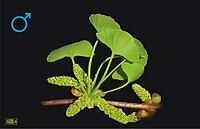
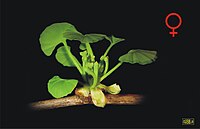
![Extinct Ginkgo yimaensis[45]](http://upload.wikimedia.org/wikipedia/commons/thumb/3/3f/Ginkgo_yimaensis.jpg/120px-Ginkgo_yimaensis.jpg)
![Extinct G. apodes[45]](http://upload.wikimedia.org/wikipedia/commons/thumb/a/a7/Ginkgo_apodes.jpg/120px-Ginkgo_apodes.jpg)
![Extinct Ginkgo adiantoides, or possibly a new US taxon, G. cranei[45]](http://upload.wikimedia.org/wikipedia/commons/thumb/a/a1/Ginkgo_adiantoides_-_G._cranii.jpg/120px-Ginkgo_adiantoides_-_G._cranii.jpg)
![Extant G. biloba[45]](http://upload.wikimedia.org/wikipedia/commons/thumb/b/b0/Ginkgo_biloba_%28new_form%29.jpg/120px-Ginkgo_biloba_%28new_form%29.jpg)



